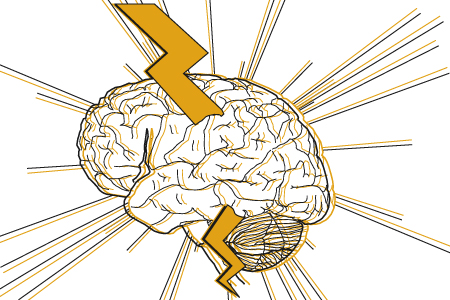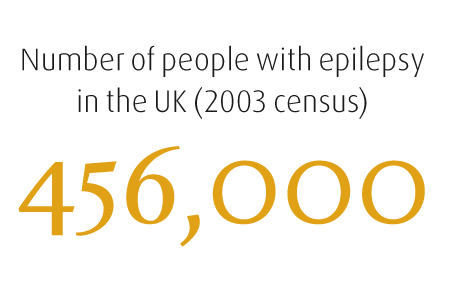
Brainstorm - A Feature on Epilepsy
Issue 66 March 2010
Epilepsy affects more than 50 million people worldwide. Dr. Noreen A. Kassem discusses the neurological condition that is likened to a thunderstorm.

Seizure Triggers
Seizures can be triggered or worsened by certain events including:
Stress and anxiety
Strong emotions such as fear, anger and worry
Poor nutrition or missing meals
Missed medication
Flickering, bright or flashing lights
Illness, fever and allergies
Lack of sleep or poor quality sleep
Heat or high humidity
The word epilepsy comes from a Greek word which means to seize, attack or overcome. This long misunderstood disorder has been surrounded by much folklore and fear since ancient times, with some Muslims citing jinn possession as the cause, but is more common than most of us realise. Epilepsy is a group of chronic neurological disorders that are characterised by sudden and brief seizures or convulsions. It is not a disease, it is a neurological condition caused by temporary disturbances in the transmission of messages sent by nerves in the brain.
Epilepsy affects approximately 1% of the population, though some individuals may experience seizures only every three to five years. This number may be higher as individuals remain undiagnosed due to the stigma, misinformation and discrimination associated with epilepsy. Epilepsy can be a frightening and very serious disorder that can greatly impact the lives of individuals affected as well as their families.
Symptoms: What Is a Seizure?
Epilepsy is primarily characterised by chronic seizures whose nature and intensity vary from person to person.
An epileptic seizure takes place when the brain functions abnormally for a brief period causing a change in movement, attention and awareness. This ‘misfiring’ of the nerves may cause loss of consciousness for short periods of time, temporary paralysis, losing control of muscles, violent jerking and spasms of the entire body or partial body. A seizure may also be a sudden stillness and a vacant stare, confusion or an emotional outburst.
There are several types of seizures; some last a few seconds or a few minutes and others occur only during certain sleep phases. It is also possible for a person with epilepsy to have more than one type of seizure.
It is important to understand that having a seizure does not mean that a person has epilepsy. Infections, high fevers, injuries and some disorders can cause isolated seizures. In epileptics, seizures are repeat and chronic, even if spaced years apart and they continue to occur for unknown reasons.
Seizures can cause exhaustion, weakness and chronic fatigue, particularly if they usually occur at night, disrupting sleep patterns. Other dangers to epileptics include harming oneself due to falling, biting, choking or hitting hard objects during a seizure. Some epileptics experience a warning sign before a seizure occurs and ensure that they are in a safe environment. This feeling is called an aura and may involve a specific feeling, smell or visual effect.
Causes of Epilepsy
In up to 60% of individuals, the cause of epilepsy is unknown. In very rare cases epilepsy is inherited and is caused by defects in a single gene or a combination of genes. These genetic factors can be triggered by environmental conditions such as stress and illness. In a rare type of epilepsy called tuberous sclerosis, genetics is the primary cause.
Treatment
It is important for epileptics to recognise when a seizure may occur and control them. A physician or neurologist will diagnose seizures, recommend treatment plans and help to provide necessary information.
Epileptics are usually treated with long-term drug therapy. However, medications are not a cure and can have numerous and often severe side effects. Different medications are used to treat varying types of seizures. Antiepileptic drugs are prescribed to prevent epileptic seizures. It is very important for the patient to take the correct dosage or amount of medication prescribed because these types of medications do not work properly unless there is a certain concentration in the blood.
Surgery is recommended only when medications fail to prevent or reduce the number of seizures, and is only a viable option if the seizures are caused by one location of the brain and if the affected tissue can be safely removed without causing damage to the brain.
Other treatments that may be recommended along with medications include biofeedback methods, acupuncture and nutrition and exercise therapy.
Epilepsy in Children
Approximately 60% of patients diagnosed with epilepsy are below the age of 18 or over the age of 60. Almost 40% are below the age of five years. Many toddlers and infants that suffer seizures show these symptoms due to pre-natal problems such as injury, infection or illness in the mother during pregnancy which affects foetal brain development. Brain injury to the infant during birth may also cause epilepsy.
Neonatal seizures occur within a month of birth. These can be difficult to determine as they usually do not have convulsions but are intermittent periods of loss of eye control, lip smacking and no breathing.
Infantile spasms occur in epileptic infants that are under a year old when the infant is sleeping, drowsy or awakening. They may occur in clusters with single seizures lasting only one to three seconds and be followed by crying that is often mistaken for colic.
Another type of epilepsy affects children between the ages of one to eight years and is more common in boys. It is characterised by frequent and often violent seizures that leave the child lethargic. This type of epilepsy is linked to delayed development and behavioural problems.
In some children, seizures stop or begin at the age of puberty. This affects females more often and may be due to increased hormonal levels. Seizures most often occur during menstruation or at the time of ovulation in females and may cause temporary speech impediments such as stuttering.
In almost 50% of childhood cases of epilepsy, seizures disappear completely in the late teen years or in early adulthood.
Case Study
Robert Age 58, father of three and account manager
I had my first seizure while playing football with my fifteen year old son in the park. I don’t remember the actual attack, but I know that it was very frightening for him. I was 56 years old and had never had a seizure or any major health problems before. I remember feeling funny and thought I was simply tired from the activity. I went to sit on a bench and the next thing I remember was lying on the ground surrounded by several people, including an off duty paramedic who had turned me onto my side to the recovery position and ensured that I was able to breathe during the seizure by supporting my head and neck. I had a full body seizure and the convulsions caused me to fall and bite my tongue and injure my arms. That first seizure was followed by another one a month later and an EEG scan of the brain by a neurologist determined that I was suffering from epileptic seizures. I was prescribed anticonvulsant medications to prevent the seizures. However, other side effects of this disorder and the medication persist such as tiredness, nausea, muscle soreness and occasional confusion. My doctor tells me that if I do not have a seizure for a year, he will slowly reduce the medication to determine if I can come off of it altogether as in some cases the seizures do not return.
Bookmark this |
|
Add to DIGG |
|
Add to del.icio.us |
|
Stumble this |
|
Share on Facebook |
|
Share this |
|
Send to a Friend |
|
Link to this |
|
Printer Friendly |
|
Print in plain text |
|


Comments
0 Comments